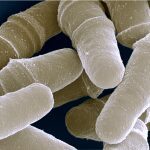Link to Pubmed [PMID] – 27738016
Science 2016 11;354(6313)
Quiescent cells play a predominant role in most organisms. Here we identify RNA interference (RNAi) as a major requirement for quiescence (G phase of the cell cycle) in Schizosaccharomyces pombe RNAi mutants lose viability at G entry and are unable to maintain long-term quiescence. We identified suppressors of G defects in cells lacking Dicer (dcr1Δ), which mapped to genes involved in chromosome segregation, RNA polymerase-associated factors, and heterochromatin formation. We propose a model in which RNAi promotes the release of RNA polymerase in cycling and quiescent cells: (i) RNA polymerase II release mediates heterochromatin formation at centromeres, allowing proper chromosome segregation during mitotic growth and G entry, and (ii) RNA polymerase I release prevents heterochromatin formation at ribosomal DNA during quiescence maintenance. Our model may account for the codependency of RNAi and histone H3 lysine 9 methylation throughout eukaryotic evolution.

